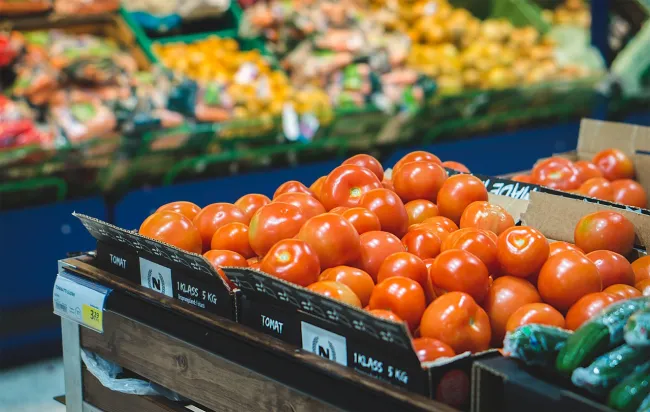This paper reports on a systematic review of grocery store interventions undertaken to evaluate their effectiveness in changing food purchasing behaviours, and to examine whether this effectiveness varied with intervention components, setting, or socioeconomic status. This is the first paper to synthesise evidence from randomised controlled trials (RCTs) in grocery stores across a wide range of intervention types.

A total of 35 studies, representing 89 interventions and over 20,000 participants, were included in this paper. The studies were conducted across 807 stores from several countries (the United States, the Netherlands, Australia, New Zealand, Canada, China, France, Sweden, and the United Kingdom). A narrative synthesis (PDF link) of the data was conducted and four categories of interventions were identified:
- Economic interventions (any intervention including a price increase, decrease, or financial reward)
- Store environment changes (any intervention involving changes to the micro-environment, such as signage or item placement)
- Swap interventions (which offer consumers the opportunity to replace their usual food with a healthier alternative), and
- Labeling and/or educational interventions (interventions involving product labeling and consumer education/ information).
In addition, the researchers conducted a qualitative comparative analysis to identify combinations of intervention components so as to evaluate the effectiveness of the intervention (measured in terms of a change in food purchasing for at least one of the foods targeted by the intervention). Of the 89 interventions, 43 were economic, 30 involved store environment changes, 6 suggested swaps and 10 used education or product labelling.
The main findings were that economic interventions were most effective in changing food purchasing, both in real and simulated stores. Their effectiveness appeared to be enhanced by additional promotional activity. Swap interventions appeared promising in real grocery stores while interventions that altered the store environment showed mixed effects. Consumer education interventions were positive in simulated environments but overall had no effect in real grocery stores. The data available suggested that the effects of economic interventions did not differ by socioeconomic status, whereas studies of other in-store interventions presented evidence of both positive and negative impacts.
The paper also assessed the overall completeness and applicability of the evidence. Overall, there are gaps in the literature as most studies reviewed were conducted in high-income countries and no interventions were conducted in real stores to test the effect of price increases. In relation to the applicability of the data, the interventions that appear most effective are also the most difficult to implement (the paper does not explain why, but it might be because options such as offering individualised product swap suggestions could be labour- or data-intensive). In addition, this review also questions the real-world value of findings from simulated grocery stores, particularly with regard to educational interventions, which appear effective in simulated grocery stores and ineffective in real grocery stores.
Abstract
Background
Diet is an important determinant of health, and food purchasing is a key antecedent to consumption.
Objective
We set out to evaluate the effectiveness of grocery store interventions to change food purchasing, and to examine whether effectiveness varied based on intervention components, setting, or socioeconomic status.
Design
We conducted a systematic review of randomized controlled trials (search performed June 2017). Studies must have: aimed to change food purchasing; been implemented in grocery stores (real or simulated); reported purchasing; and had a minimal control or compared interventions fulfilling our criteria. Searching, screening, bias assessment, and data extraction followed Cochrane methods. We grouped studies by intervention type (economic, environmental, swaps, and/or education), synthesized results narratively, and conducted an exploratory qualitative comparative analysis.
Results
We included 35 studies representing 89 interventions, >20,000 participants, and >800 stores. Risk of bias was mixed. Economic interventions showed the most promise, with 8 of the 9 studies in real stores and all 6 in simulated environments detecting an effect on purchasing. Swap interventions appeared promising in the 2 studies based in real stores. Store environment interventions showed mixed effects. Education-only interventions appeared effective in simulated environments but not in real stores. Available data suggested that effects of economic interventions did not differ by socioeconomic status, whereas for other interventions impact was variable. In our qualitative comparative analysis, economic interventions (regardless of setting) and environmental and swap interventions in real stores were associated with statistically significant changes in purchasing in the desired direction for ≥1 of the foods targeted by the intervention, whereas education-only interventions in real stores were not.
Conclusions
Findings suggest that interventions implemented in grocery stores—particularly ones that manipulate price, suggest swaps, and perhaps manipulate item availability—have an impact on purchasing and could play a role in public health strategies to improve health. Review protocol registered at https://www.crd.york.ac.uk/PROSPERO/ as CRD42017068809.
Reference
Hartmann-Boyce, J., Bianchi, F., Piernas, C., Riches, S.P., Frie, K., Nourse, R. and Jebb, S.A., 2018. Grocery store interventions to change food purchasing behaviours: a systematic review of randomized controlled trials. The American journal of clinical nutrition, 107(6), pp.1004-1016.
Read the full article here. See also the Foodsource resource What interventions could potentially shift our eating patterns in sustainable directions?




Comments (0)